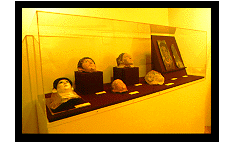![]()
 In human images from ancient Egypt attention
was centered, first and foremost, on the face. The face of any representation
of a person contained important information about identity. Among the most
common of facial portraits was the mummy mask on a dead body. Such masks
were not intended as portraits as much as idealized images to serve the
deceased in the afterlife. These ideal images of faces often encode complex
information about status and, not surprisingly, gender. Color (often pink
or reddish brown for male but a light color for female), shape, indications
of facial hair, gender-specific jewelry such as earrings, hairstyles, and
headdresses are all clues to gender identity. When such signs of gender
are absent from Egyptian faces, we must consider whether they have been
lost or were never originally present.
In human images from ancient Egypt attention
was centered, first and foremost, on the face. The face of any representation
of a person contained important information about identity. Among the most
common of facial portraits was the mummy mask on a dead body. Such masks
were not intended as portraits as much as idealized images to serve the
deceased in the afterlife. These ideal images of faces often encode complex
information about status and, not surprisingly, gender. Color (often pink
or reddish brown for male but a light color for female), shape, indications
of facial hair, gender-specific jewelry such as earrings, hairstyles, and
headdresses are all clues to gender identity. When such signs of gender
are absent from Egyptian faces, we must consider whether they have been
lost or were never originally present.
![]()